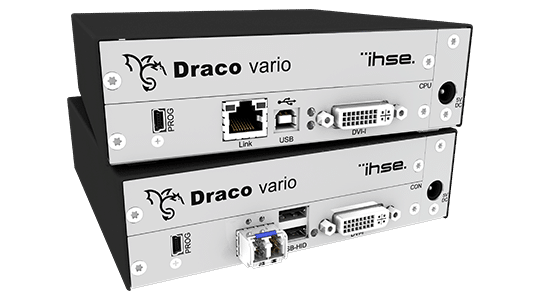Home / Solutions / Broadcast and Post Production / SRF
srf - Tcp
SRF provides access and control of computers in busy studio complex using Draco tera enterprise matrix switch
The Customer

Schweizer Radio und Fernsehen (SRF) provides TV and radio services to viewers and listeners across Switzerland with a bouquet of 6 radio channels and 3 TV channels.
The Challenge
tpc (technology and production center switzerland ag), the production and technical service provider for SRF was recently tasked with the goal of
providing a full computer switching system throughout a new building. The system had several critical requirements: it needed to be scalable without using cascading techniques, futureproof for growth, compatible with the BFE studio control system used throughout the facility, it needed to be able to instantly switch the connections between 135 computers and 56 user terminals transmitting 1900 x 1200 DVI-D digital signals. Most importantly, the installation had to be completed within an extremely tight timescale of just 10 weeks between completion of system design and full commissioning and testing to meet the planned on-air date in January 2012.
The Solution
The solution provided by IHSE was the new 288- port Draco tera enterprise KVM matrix switch. This would be heavily populated with Cat X input/output ports to enable the connections needed throughout the building. Each port can be user-configured as either an input or output port which greatly simplifies installation and provides it with a high level of flexibility for future changes to the system or network. Sufficient spare capacity was allowed in the chassis to add additional input and output ports in the future as and when these are required.
In use, each connection between a terminal and computer carries full HD video content up to 1920 x 1200 resolution using DVI-D interfaces, with keyboard, mouse and HID connectivity, including USB 2.0 to provide full access and control of the computer.
Draco tera provides several types of control mechanisms to configure and manage the whole system including Java-based GUI, local OSD (on-screen display), serial and IP network interfaces. Within the system at tpc/SRF a combination of control interfaces is used: local control by operators is achieved using ‘hotkeys’ on their keyboards to switch sources and displays; more complex Draco tera set up and configuration is handled by means of the OSD function; whilst the BFE KCS broadcast control system communicates with the Draco tera over an IP network link to manage and control the whole system. This means that the system is fully controlled at all levels in the most efficient way possible.
The Benefit
“Despite the fact that the Draco tera was at an advanced pre-production stage at the time of ordering, we are glad to have chosen this product. It met all our requirements and provides further possibilities for expansion,” said Jens Schulz, project manager at tpc.
“During the initial design phase and as we worked through the project, additional features and functions were identified that would give the system greater flexibility and provide more powerful operation. These were developed by IHSE very rapidly over the course of a few months as the system integration proceeded.”
The dedicated features included virtual mapping of computers so that there was a link from users only to virtual machines, rather than physical ones, allowing greater granularity of routing, spreading of resources and enhanced security through access restriction to users. The assignment of users to virtual machines is controlled dynamically by the BFE system with instant effect, achieving faster response than could be achieved through physical mapping through the matrix switch alone. Additional layers of redundancy were also included to enhance the reliability of the integrated solution.
tpc/SRF, like most organisations, possesses a number of legacy computers and systems containing valuable material produced to different video and graphic formats. IHSE developed a new series of converter-scaler units to enable this material to be upscaled prior to conversion and input to the Draco tera. This allowed tpc/SRF to continue using older resources without expensive replacement or reformatting.
Following on from the success of this initial project a new installation is planned for early 2013 with another Draco tera enterprise system.



